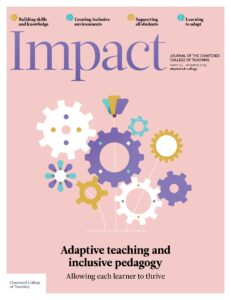The shift to adaptive teaching: A research-informed guide
Written by: Mark Leswell

8 min read
MARK LESWELL, RESEARCH LEAD, SWALE ACADEMIES TRUST, UK
Introduction
The number of students identified as having special educational needs and disabilities (SEND) is increasing. In England, for example, 1.7 million pupils were identified as having SEND in 2024, representing 18.4 per cent of all pupils (DfE, 2024). Despite our dedicated efforts, the educational outcomes for students with SEND continue to lag significantly behind their peers without SEND. For example, those pupils with SEND that have statements or education, health and care plans (EHCPs) achieve a Progress 8 score of -1.09 (Thomson, 2019).
The challenges facing students with SEND are multifaceted and complex. Prior attainment data reveals that almost 40 per cent of pupils with SEND in mainstream schools achieved a mean Key Stage 2 fine grade of 3.0 or lower, compared to just one per cent of pupils without SEND (Thomson, 2019). The performance gap for students with SEND in mainstream settings is less pronounced tha
Join us or sign in now to view the rest of this page
You're viewing this site as a guest, which only allows you to view a limited amount of content.
To view this page and get access to all our resources, join the Chartered College of Teaching (it's free for trainee teachers and half price for ECTs) or log in if you're already a member.
- Barnes M and Harrison E (2017) The wellbeing of secondary school pupils with special educational needs: Research report. Department for Education. Available at: https://assets.publishing.service.gov.uk/media/5a82201fe5274a2e8ab57a08/Wellbeing_and_SEN.pdf (accessed 4 March 2025).
- Brühwiler C and Blatchford P (2011) Effects of class size and adaptive teaching competency on classroom processes and academic outcome. Learning and Instruction 21(1): 95–108.
- Department for Education (DfE) (2024) Special educational needs in England: Academic year 2023/24. Available at: https://explore-education-statistics.service.gov.uk/find-statistics/special-educational-needs-in-england/2023-24 (accessed 4 March 2025).
- Deunk MI, Doolaard S, Smale-Jacobse AE et al. (2015) Differentiation Within and Across Classrooms: A Systematic Review of Studies Into the Cognitive Effects of Differentiation Practices. Groningen: GION onderwijs/onderzoek. Available at: www.nro.nl/sites/nro/files/migrate/Differentiation-within-and-across-classrooms-Review.pdf (accessed 4 March 2025).
- Deunk MI, Smale-Jacobse AE, De Boer H et al. (2018) Effective differentiation practices: A systematic review and meta-analysis of studies on the cognitive effects of differentiation practices in primary education. Educational Research Review 24: 31–54.
- Education Endowment Foundation (EEF) (2021) Special educational needs in mainstream schools: Guidance report. Available at: https://educationendowmentfoundation.org.uk/education-evidence/guidance-reports/send (accessed 4 March 2025).
- Macqueen S (2012) Academic outcomes from between-class achievement grouping: The Australian primary context. Australian Educational Researcher 39: 59–73.
- Parsons SA, Vaughn M, Scales RQ et al. (2018) Teachers’ instructional adaptations: A research synthesis. Review of Educational Research 88(2): 205–242.
- Thomson D (2019) Progress 8 for pupils with SEN: Are P8 scores really that low? FFT Education Datalab. Available at: https://ffteducationdatalab.org.uk/2019/01/progress-8-for-pupils-with-sen-are-p8-scores-really-that-low (accessed 4 March 2025).
- Tomlinson CA, Brighton C, Hertberg H et al. (2003) Differentiating instruction in response to student readiness, interest and learning profile in academically diverse classrooms: A review of literature. Journal for the Education of the Gifted 27: 119–145.
- Van Geel M, Keuning T, Frèrejean J et al. (2019) Capturing the complexity of differentiated instruction. School Effectiveness and School Improvement 30(1): 51–67.











A superb piece; thank you, Mark. We’re using this as the starting point for an upcoming PD session.